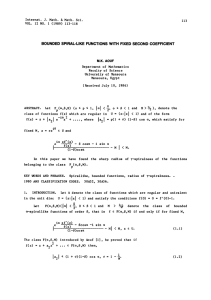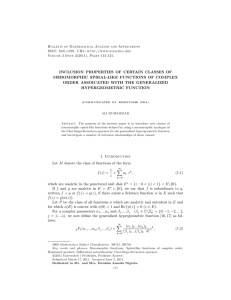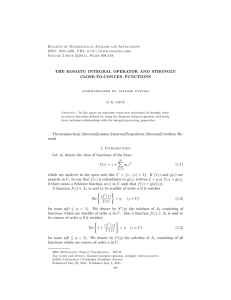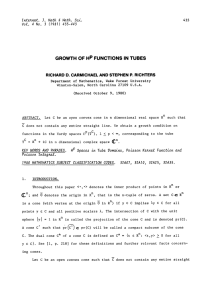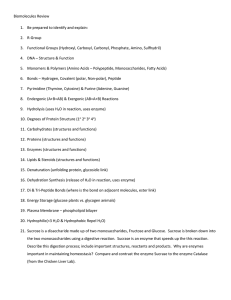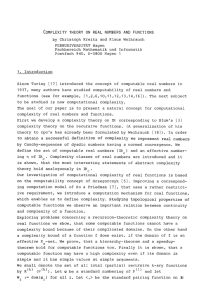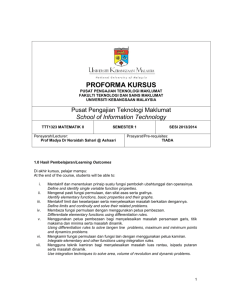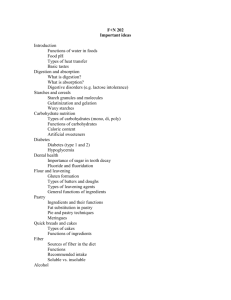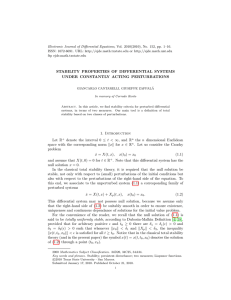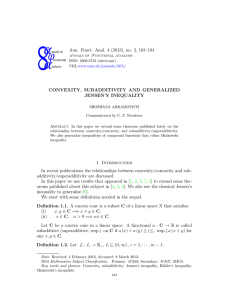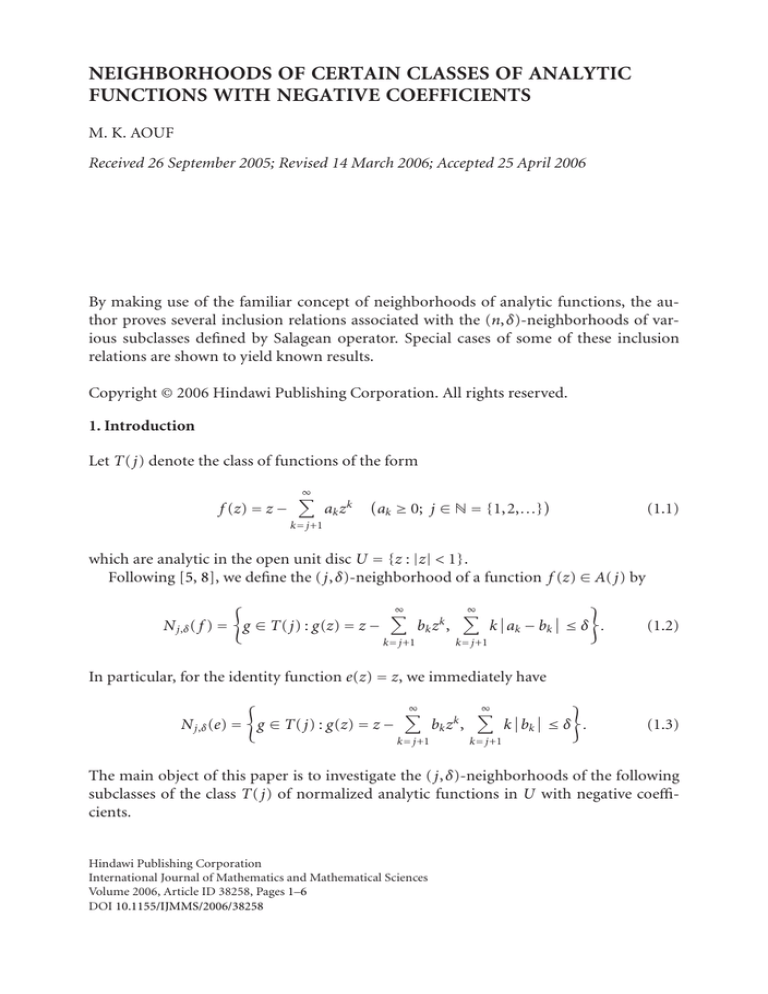
NEIGHBORHOODS OF CERTAIN CLASSES OF ANALYTIC
FUNCTIONS WITH NEGATIVE COEFFICIENTS
M. K. AOUF
Received 26 September 2005; Revised 14 March 2006; Accepted 25 April 2006
By making use of the familiar concept of neighborhoods of analytic functions, the author proves several inclusion relations associated with the (n,δ)-neighborhoods of various subclasses defined by Salagean operator. Special cases of some of these inclusion
relations are shown to yield known results.
Copyright © 2006 Hindawi Publishing Corporation. All rights reserved.
1. Introduction
Let T( j) denote the class of functions of the form
f (z) = z −
∞
ak z k
ak ≥ 0; j ∈ N = {1,2,...}
(1.1)
k= j+1
which are analytic in the open unit disc U = {z : |z| < 1}.
Following [5, 8], we define the ( j,δ)-neighborhood of a function f (z) ∈ A( j) by
N j,δ ( f ) = g ∈ T( j) : g(z) = z −
∞
bk zk ,
k= j+1
∞
kak − bk ≤ δ .
(1.2)
k= j+1
In particular, for the identity function e(z) = z, we immediately have
N j,δ (e) = g ∈ T( j) : g(z) = z −
∞
k= j+1
bk zk ,
∞
kbk ≤ δ .
(1.3)
k= j+1
The main object of this paper is to investigate the ( j,δ)-neighborhoods of the following
subclasses of the class T( j) of normalized analytic functions in U with negative coefficients.
Hindawi Publishing Corporation
International Journal of Mathematics and Mathematical Sciences
Volume 2006, Article ID 38258, Pages 1–6
DOI 10.1155/IJMMS/2006/38258
2
Neighborhoods of certain classes
For a function f (z) ∈ T( j), we define
D0 f (z) = f (z),
D1 f (z) = D f (z) = z f (z),
Dn f (z) = D Dn−1 f (z)
(1.4)
(n ∈ N).
The differential operator Dn was introduced by Sălăgean [9]. With the help of the differential operator Dn , we say that a function f (z) ∈ T( j) is in the class T j (n,m,α) if and
only if
Dn+m f (z)
Re
Dn f (z)
>α
(n ∈ N0 = N ∪ {0}, m ∈ N)
(1.5)
for some α (0 ≤ α < 1), and for all z ∈ U.
The operator Dn+m was studied by Sekine [11], Aouf et al. [2], Aouf et al. [3], and
Hossen et al. [6]. We note that T j (0,1,α) = S∗j (α), the class of starlike functions of order
α, and T j (1,1,α) = C j (α), the class of convex functions of order α (Chatterjea [4] and
Srivastava et al. [12]).
2. Neighborhood for the class T j (n,m,α)
For the class T j (n,m,α), we need the following lemma given by Sekine [11].
Lemma 2.1. A function f (z) ∈ T( j) is in the class T j (n,m,α) if and only if
∞
k n k m − α ak ≤ 1 − α
(2.1)
k= j+1
for n,m ∈ N0 and 0 ≤ α < 1. The result is sharp.
Applying the above lemma, we prove the following.
Theorem 2.2. T j (n,m,α) ⊂ N j,δ (e), where
δ=
(1 − α)
.
( j + 1)m − α
( j + 1)n−1
(2.2)
Proof. It follows from (2.1) that if f (z) ∈ T j (n,m,α), then
∞
( j + 1)n−1 ( j + 1)m − α
kak ≤ 1 − α,
(2.3)
k= j+1
that is, that
∞
k= j+1
kak ≤
1−α
= δ,
( j + 1)n ( j + 1)m − 1
which, in view of definition (1.3), proves Theorem 2.2.
(2.4)
M. K. Aouf 3
Putting j = 1 in Theorem 2.2, we have the following.
Corollary 2.3. T1 (n,m,α) ⊂ N1,δ (e), where δ = (1 − α)/2n−1 2m − α .
Remark 2.4. (i) Putting n = 0 and m = 1 in Theorem 2.2 and Corollary 2.3, we obtain the
results obtained by Altintas and Owa [1].
(ii) Putting n = m = 1 in Theorem 2.2 and Corollary 2.3, we obtain the results obtained by Altintas and Owa [1].
3. Neighborhoods for the classes R j (n,α) and P j (n,α)
A function f (z) ∈ T( j) is said to be in the class R j (n,α) if it satisfies
Re Dn f (z) > α
(z ∈ U)
(3.1)
for some α (0 ≤ α < 1) and n ∈ N0 . The class R1 (n,α) was studied by Yaguchi and Aouf
[13]. We note that R j (0,α) = R j (α) (Sarangi and Uralegaddi [10]).
Further, a function f (z) ∈ T( j) is said to be a member of the class P j (n,α) if it satisfies
Re
Dn f (z)
>α
z
(z ∈ U)
(3.2)
for some α (0 ≤ α < 1) and z ∈ U. The class P1 (n,α) was studied by Nunokawa and Aouf
[7].
It is easy to see the following.
Lemma 3.1. A function f (z) ∈ T( j) is in the class R j (n,α) if and only if
∞
kn+1 ak ≤ 1 − α.
(3.3)
k= j+1
The result is sharp.
Lemma 3.2. A function f (z) ∈ T( j) is in the class P j (n,α) if and only if
∞
kn ak ≤ 1 − α.
(3.4)
k= j+1
The result is sharp.
From the above lemmas, we see that R j (n,α) ⊂ P j (n,α).
Theorem 3.3. R j (n,α) ⊂ N j,δ (e), where
δ=
1−α
.
( j + 1)n
(3.5)
Proof. If f (z) ∈ R j (n,α), we have
( j + 1)n
∞
k= j+1
kak ≤ 1 − α,
(3.6)
4
Neighborhoods of certain classes
which gives
∞
kak ≤
k= j+1
1−α
= δ,
( j + 1)n
(3.7)
which, in view of definition (1.3), proves Theorem 3.3.
Putting j = 1 in Theorem 2.2, we have the following.
Corollary 3.4. R1 (n,α) ⊂ N1,δ (e), where δ = (1 − α)/2n .
Theorem 3.5. P j (n,α) ⊂ N j,δ (e), where
δ=
1−α
.
( j + 1)n−1
(3.8)
Proof. If f (z) ∈ P j (n,α), we have
( j + 1)n−1
∞
kak ≤ 1 − α,
(3.9)
1−α
= δ,
( j + 1)n−1
(3.10)
k= j+1
which gives
∞
k= j+1
kak ≤
which, in view of definition (1.3), proves Theorem 3.5.
Putting j = 1 in Theorem 3.5, we have the following.
Corollary 3.6. P1 (n,α) ⊂ N1,δ (e), where δ = (1 − α)/2n−1 .
4. Neighborhood for the class K j (n,m,α,β)
A function f (z) ∈ T( j) is said to be in the class K j (n,m,α,β) if it satisfies
f (z)
g(z) − 1 < 1 − α
(z ∈ U)
(4.1)
for some α (0 ≤ α < 1) and g(z) ∈ T j (n,m,β) (0 ≤ β < 1).
Theorem 4.1. N j,δ (g) ⊂ K j (n,m,α,β), where g(z) ∈ T j (n,m,β) and
( j + 1)n−1 ( j + 1)m − β δ
,
α = 1−
( j + 1)n ( j + 1)m − β − 1 + β
where δ ≤ ( j + 1) − (1 − β)( j + 1)1−n [( j + 1)m − β]−1 .
(4.2)
M. K. Aouf 5
Proof. Let f (z) be in N j,δ (g) for g(z) ∈ T j (n,m,β). Then we know that
∞
kak − bk ≤ δ,
k= j+1
(4.3)
∞
1−β
.
bk ≤
n ( j + 1)m − β
(
j
+
1)
k= j+1
Thus we have
∞
f (z)
k= j+1 ak − bk
g(z) − 1 ≤ 1 − ∞
k= j+1 bk
( j + 1)n ( j + 1)m − β
δ
≤
·
j + 1 ( j + 1)n ( j + 1)m − β − 1 + β
(4.4)
( j + 1)n−1 ( j + 1)m − β δ
=
= 1 − α.
( j + 1)n ( j + 1)m − β − 1 + β
This implies that f (z) ∈ K j (n,m,α,β).
Putting j = 1 in Theorem 4.1, we have the following.
Corollary 4.2. N1,δ (g) ⊂ K1 (n,m,α,β), where g(z) ∈ T1 (n,m,β) and
2 n −1 2 m − β δ
α = 1 − n m
.
2 2 −β −1+β
(4.5)
Remark 4.3. Putting n = 0 and m = 1 in Theorem 4.1 and Corollary 4.2, we obtain the
results obtained by Altintas and Owa [1].
Acknowledgment
The author would like to thank the referee of the paper for helpful suggestions.
References
[1] O. Altintas and S. Owa, Neighborhoods of certain analytic functions with negative coefficients,
International Journal of Mathematics and Mathematical Sciences 19 (1996), no. 4, 797–800.
[2] M. K. Aouf, H. E. Darwish, and A. A. Attiya, Generalization of certain subclasses of analytic functions with negative coefficients, Universitatis Babeş-Bolyai. Studia. Mathematica 45 (2000), no. 1,
11–22.
[3] M. K. Aouf, H. M. Hossen, and A. Y. Lashin, On certain families of analytic functions with negative
coefficients, Indian Journal of Pure and Applied Mathematics 31 (2000), no. 8, 999–1015.
[4] S. K. Chatterjea, On starlike functions, Journal of Pure Mathematics 1 (1981), 23–26.
[5] A. W. Goodman, Univalent functions and nonanalytic curves, Proceedings of the American Mathematical Society 8 (1957), no. 3, 598–601.
[6] H. M. Hossen, G. S. Sălăgean, and M. K. Aouf, Notes on certain classes of analytic functions with
negative coefficients, Mathematica 39(62) (1997), no. 2, 165–179.
6
Neighborhoods of certain classes
[7] M. Nunokawa and M. K. Aouf, On certain subclasses of univalent functions with negative coefficients, Sūrikaisekikenkyūsho Kōkyūroku (1995), no. 917, 15–39.
[8] S. Ruscheweyh, Neighborhoods of univalent functions, Proceedings of the American Mathematical Society 81 (1981), no. 4, 521–527.
[9] G. S. Sălăgean, Subclasses of univalent functions, Complex Analysis–Fifth Romanian-Finnish
Seminar, Part 1 (Bucharest, 1981), Lecture Notes in Math., vol. 1013, Springer, Berlin, 1983,
pp. 362–372.
[10] S. M. Sarangi and B. A. Uralegaddi, The radius of convexity and starlikeness for certain classes
of analytic functions with negative coefficients. I, Atti della Accademia Nazionale dei Lincei 65
(1978), no. 1-2, 38–42 (1979).
[11] T. Sekine, Generalization of certain subclasses of analytic functions, International Journal of Mathematics and Mathematical Sciences 10 (1987), no. 4, 725–732.
[12] H. M. Srivastava, S. Owa, and S. K. Chatterjea, A note on certain classes of starlike functions,
Rendiconti del Seminario Matematico della Università di Padova 77 (1987), 115–124.
[13] T. Yaguchi and M. K. Aouf, A generalization of a certain subclass of analytic functions with negative
coefficients, Scientiae Mathematicae 1 (1998), no. 2, 157–168.
M. K. Aouf: Department of Mathematics, Faculty of Science, University of Mansoura,
Mansoura 35516, Egypt
E-mail address: mkaouf@mans.edu.eg

